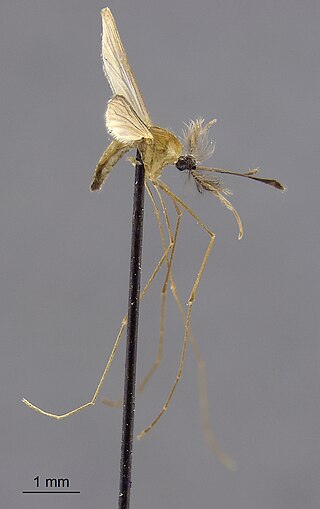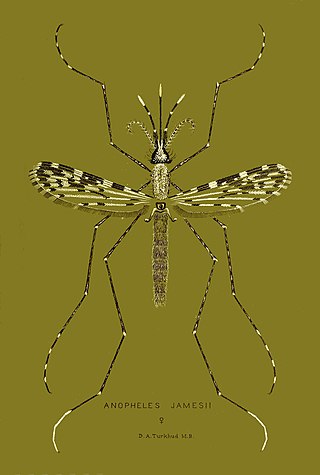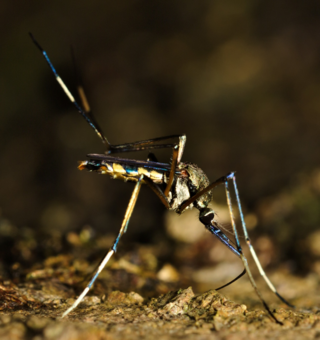Anopheles (Cellia) subpictus is a species complex of four species of mosquito belonging to the genus Anopheles.

Anopheles stephensi is a primary mosquito vector of malaria in urban India and is included in the same subgenus as Anopheles gambiae, the primary malaria vector in Africa. A. gambiae consists of a complex of morphologically identical species of mosquitoes, along with all other major malaria vectors; however, A. stephensi has not yet been included in any of these complexes. Nevertheless, two races of A. stephensi exist based on differences in egg dimensions and the number of ridges on the eggs; A. s. stephensisensu stricto, the type form, is a competent malaria vector that takes place in urban areas, and A. s. mysorensis, the variety form, exists in rural areas and exhibits considerable zoophilic behaviour, making it a poor malaria vector. However, A. s. mysorensis is a detrimental vector in Iran. An intermediate form also exists in rural communities and peri-urban areas, though its vector status is unknown. About 12% of malaria cases in India are due to A. stephensi.

Anopheles barbirostris is a species complex of mosquito belonging to the genus Anopheles. Larvae found in clean, lotic bodies of water. Females are zoophilic, mainly feed blood on cattle and humans. It is also an important vector for Plasmodium falciparum in Sri Lanka and Timor, for both Plasmodium vivax and P. falciparum in Bangladesh.
Anopheles barbumbrosus is a species complex of mosquito belonging to the genus Anopheles. It has 12-36 thin attenuated branches usually loose and separated out, which is a good indication to separate it from A. barbirostris. It shows a marked zoophilic tendency, thus is a malaria vector, but with minor importance to humans. It is distributed throughout Peninsular Malaysia, Sumatra, Java, Thailand, India and Sri Lanka, They mostly live as an outdoor mosquito species, rarely found indoor places. Larva can be found in a variety of habitats including both partially shaded and sunlit fresh and slowly running water, grass-fringed streams to stagnant water pools and man-made places like rice fields.
Anopheles elegans is a species complex of mosquito belonging to the genus Anopheles. It is found in India and Sri Lanka. In India, it is known to breed in shaded stagnant waters and tree holes. It is a natural vector of simian malaria in both countries.
Anopheles gigas is a species complex of mosquito belonging to the genus Anopheles. It is endemic to Sri Lanka. Two subspecies recorded.

Anopheles insulaeflorum is a species complex of mosquito belonging to the genus Anopheles. It is found in India, Sri Lanka, Cambodia, China, Indonesia, Malaysia, Myanmar, Philippines, Taiwan, Thailand, and Vietnam.

Anopheles (Cellia) jamesii is a species complex of mosquito belonging to the genus Anopheles. It is found in India, and Sri Lanka, Bangladesh, Cambodia, China, Laos, Malaysia, Myanmar, Nepal, Thailand, and Vietnam. It is a potential natural vector of bancroftian filariasis in Sri Lanka.
Anopheles (Cellia) karwari is a species complex of zoophilic mosquito belonging to the genus Anopheles. It is found in India, and Sri Lanka, Bangladesh, Sumatra, and Java. A. karwari is a member of the Maculatus Group and the second scarcest species reported from Indonesia. Female is blood sucking and involved in transmitting Plasmodium falciparum, thus an important malarial vector. It is considered a secondary vector in the Australian region, but its vectorial status in South-East Asia was unknown.
Anopheles (Anopheles) nigerrimus is a species complex of zoophilic mosquito belonging to the genus Anopheles. It belongs to the Nigerrimus Subgroup and Hyrcanus Group of the Myzorhynchus Series. It is found in India, and Sri Lanka, Bangladesh, Brunei, Cambodia, China, Malaysia, Myanmar, Nepal, Pakistan, Thailand, and Vietnam. It is a Possible malaria and filariasis vector. It is found from ecosystems nearby water courses such as rice fields, canals, large open marshes, and also in partially sunny, shady deep pools with floating vegetation. In Sri Lanka, the adult and larval stages are known to show resistant to a range of organophosphate and carbamate insecticides. Cytologically, two karyotypic forms of A. nigerrimus are identified, as Form A and B.
Anopheles pallidus is a species complex of mosquito belonging to the genus Anopheles. It is found in India, and Sri Lanka and Myanmar. It is a potential natural vector of bancroftian filariasis in Sri Lanka as well as Malaria and Babesiosis in other countries.
Anopheles (Anopheles) peditaeniatus is a species complex of mosquito belonging to the genus Anopheles, of the Hyrcanus Group. It is found in India, and Sri Lanka, Iran, and Bangladesh. It is a potential natural vector of bancroftian filariasis in Sri Lanka.
Anopheles (Anopheles) reidi is a species complex of barbirostris mosquito belonging to the genus Anopheles. It is endemic to Sri Lanka.
Anopheles (Cellia) tessellatus is a species complex of zoophilic mosquito belonging to the genus Anopheles. It is found in India, and Sri Lanka, Bangladesh, Cambodia, China, Indonesia, Malaysia, Laos, Maldives, Myanmar, Nepal, Philippines, Taiwan, Thailand and Vietnam. It is first described from Sri Lanka. Larvae are known to found from dirty stagnant water in sun or shady habitats. Adults are zoophilic. It is not regarded as a malaria vector, but is a secondary vector of Wuchereria bancrofti in Maldives.
Anopheles (Cellia) vagus is a species complex of zoophilic mosquito belonging to the genus Anopheles. It is found in India, Sri Lanka and Indonesia. It is a potential natural vector of malarial parasite Plasmodium falciparum, and Japanese encephalitis virus. It is highly susceptible to insecticide deltamethrin and resistant to DDT.
Anopheles (Cellia) varuna is a species complex of zoophilic mosquito belonging to the genus Anopheles. It is found in India, Sri Lanka Thailand and Vietnam. It is a secondary malaria vector in Sri Lanka. Larvae are known to feed on detritus, rod and cocci bacteria, diatom, filamentous algae and desmids. A microsporidium Thelohania obscura was discovered from the larvae in India in 1966.

Toxorhynchites (Toxorhynchites) splendens is a species of non-hematophagous mosquito belonging to the genus Toxorhynchites. It is widely used as a predator to control dengue mosquitoes.
Culex (Lutzia) fuscanus is a species of mosquito belonging to the genus Culex. It is found in China, India, Indonesia and Sri Lanka They are natural predators of disease causing mosquito larva such as Aedes aegypti, Anopheles subpictus, and Culex tritaeniorhynchus.
The 1906 malaria outbreak in Ceylon, was a major malaria outbreak in Ceylon during the early twentieth century. The first cases were reported in the early 1900s but not officially recorded until 1906. Malaria has been prevalent on the island since the 3rd century B.C. Malaria is caused by single-cell microorganisms of Plasmodium group. This disease is commonly spread by the female Anopheles mosquito. Most Anopheles mosquito species are native in Sri Lanka. There are four main mosquito species on the island including: Anopheles culicifacies, Anopheles subpictus, Anopheles annularis and Anopheles varuna.




